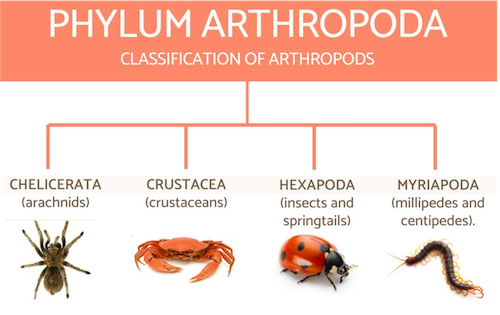Even if it might gross us out now, experts predict that edible insects will play a significant role in our future diets. Not only are these bugs rich in protein and nutrients, but they can also be farmed more sustainably. For example, farmed crickets have a water footprint roughly 1/3 the size of beef cattle, require 50-90% less land, and emit 100 times less greenhouse gas during the farming process. In addition, where most of a cow is inedible to humans, roughly 80% of a cricket can be eaten, meaning less waste.
All things considered, it is in our best interest to get comfortable with eating insects. Unless you're allergic to shellfish, that is.
Shellfish allergies are highly prevalent throughout the world, particularly in places where consumption is high. It's estimated that 2% of people worldwide show immune responses to shellfish. In the U.S., roughly 6.5 million individuals have a shellfish allergy, making it twice as common as a peanut allergy. Shellfish plus seven other common allergens (milk, eggs, fish, tree nuts, peanuts, wheat and soy) make up 90% of food allergies in the U.S. that are not outgrown after childhood.
It's not only through eating shellfish that one can have an allergic reaction. Occupational exposure at shellfish processing plants can cause reactions, often just through inhaling the airborne particles of crustaceans.
Unfortunately, the edible-insect revolution is not very welcoming for the many affected by a shellfish allergy. Upon consumption of crickets, mealworms or other insects, individuals with shellfish allergies have a good chance of having an allergic reaction. This is even true for the occupational exposure route, with reports of cricket farm or pet store workers sensitive to shellfish having reactions.
The high potential for cross-allergic reactions between insects and shellfish might only make sense once you look at their phylogenetic tree. Shellfish is a colloquial term encompassing any ocean-dwelling animal with an exoskeleton. Almost none of them are actually fish. Bearers of the shellfish moniker come from three different phyla: Mollusca, containing mollusks like snails, clams, and octopi; Echinodermata, containing echinoderms like sea urchins and sea cucumbers; and crustaceans like shrimp and lobster, which are actually a subset of the phylum Arthropoda.

Photo source: https://www.ncbi.nlm.nih.gov/pmc/articles/PMC5306157/
You might know arthropods as all the things we typically call "bugs," like spiders, millipedes, and all sorts of insects. Crustaceans like crayfish or prawns are, quite literally, just the bugs of the sea. With this evolutionary relationship in mind, it's easier to imagine how immune systems often fail to differentiate between bugs of the land and the ocean.

Photo source: https://www.animalwised.com/classification-of-invertebrates-chart-with-definitions-and-examples-3657.html
Most shellfish allergies are due to the immune system reacting to proteins. There are a few different proteins in shellfish responsible (around 34), including arginine kinase and sarcoplasmic calcium-binding protein, but the overwhelming majority of those with shellfish allergies show sensitivity to the protein tropomyosin.
As Dr. Zachary Rubin, pediatric allergist, wrote to me, "The majority of people allergic to shellfish are allergic to a protein called tropomyosin, which is also found in many insects, so it's not usually a good idea to consume insect-containing foods if you have a shellfish allergy."
If you've studied biology or seen the famous “The Inner Life of the Cell” animation, you might recognize tropomyosin as one of the proteins integral to our muscles contracting. Without tropomyosin, I couldn't move my fingers to type this article. But if tropomyosin is found in the proteins of most animals, why are so many people allergic to shellfish tropomyosins but not other animal tropomyosins?
It comes down to the sequence of amino acids that make up a tropomyosin protein. You can think of a protein as a chain, with each individual link being an amino acid. A protein chain can be constructed of many different combinations of amino acids in various orders to create countless distinct proteins with unique properties.
All tropomyosin proteins are similar to a certain degree—otherwise, they wouldn't be tropomyosin proteins—but even working within these bounds, tropomyosin is afforded significant variation in its amino acid sequence between different animals. Some animals are more similar to others. Across various crustacean species such as prawns, crabs, and lobsters, amino acid identities can reach 95–100% similarity. The tropomyosin amino acid sequence is well preserved across shellfish, even though they belong to two different genetic phyla: Arthropoda and Mollusca.
Tropomyosin is the culprit allergen for cross-reactions between those allergic to shellfish and insects like crickets, fruit flies, grasshoppers, cockroaches, locusts, and dust mites.
One 2020 study found that certain insect species elicited less of an immune response from shrimp tropomyosin allergic patients. Mealworm larvae, waxworm larvae and superworm larvae may represent less allergenic insect options.
Another specific aspect of shellfish tropomyosins that may contribute to their allergenicity is their high thermostability. When proteins are heated, most will melt. Typically, this means that they are no longer active. Having lost their 3D structure, the proteins can’t be recognized by receptors or other important molecules and isn’t detectable by the immune system.
Treating proteins under high heat to denature them can be a strategy for making hypoallergenic products. The tricky thing is that the temperature needed to denature changes based on the protein. For example, tropomyosins happen to have very high melting points. This thermostability is thought to contribute to the highly allergenic nature of these proteins since treatment with heat, or even high pressure, isn't sufficient to render them anallergenic.
Unfortunately, due mainly to tropomyosin and a handful of other allergenic proteins, the edible insect revolution is not for those with shellfish allergies. Given the popularity of alternative protein choices for pet foods, you may want to keep the shellfish-insect connection in mind when choosing kibble for your furry friends.







